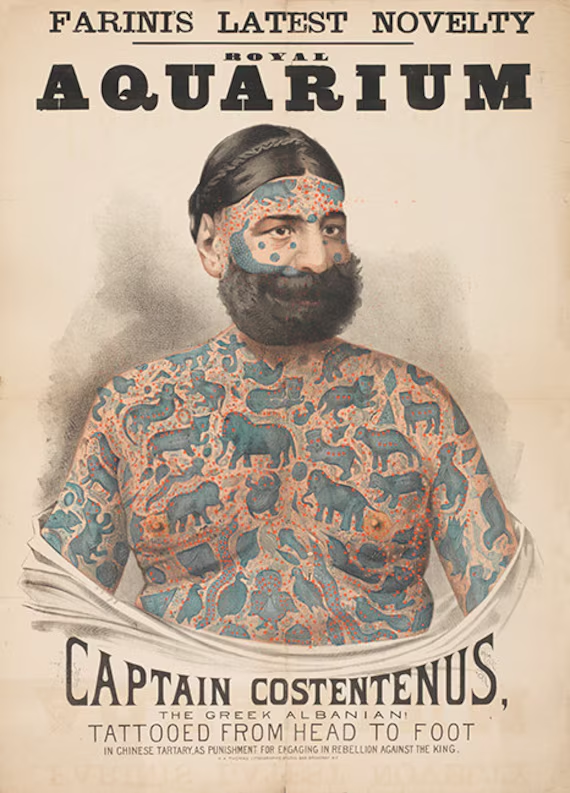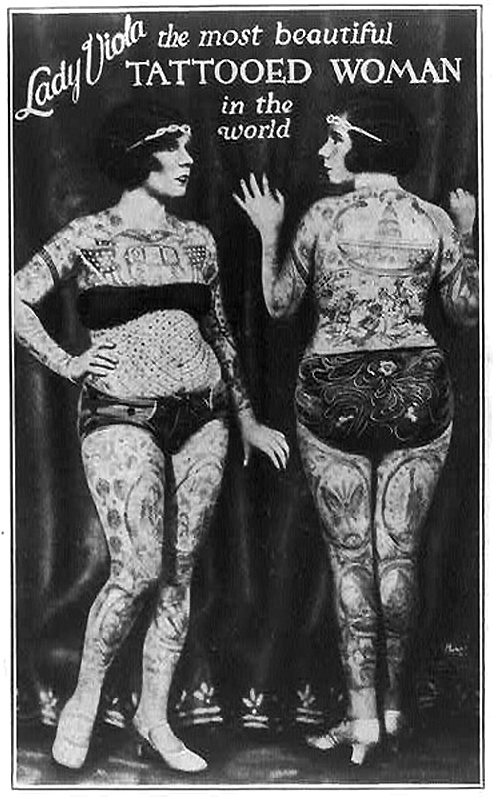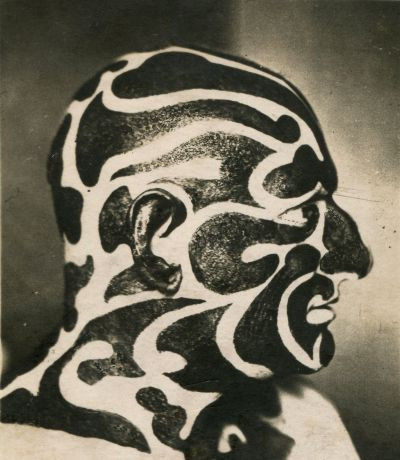Ink Under the Big Top: Tattooed Wonders of the Sideshow
- thebluebloodstudios

- Apr 28
- 4 min read
A Glimpse Behind the Canvas: The Allure of the Unusual
Imagine stepping beneath the canvas of a turn-of-the-century sideshow tent. The air hums with a peculiar energy, a mix of earthy sawdust and the thrill of the unusual. Among the daring feats of sword swallowers and the captivating presence of bearded ladies, figures adorned with elaborate skin illustrations often drew a special kind of gaze. Their bodies, living surfaces etched with intricate designs, whispered silent narratives, a bold visual statement in a world that largely frowned upon such permanent markings.

Living Galleries: Spectacles of Ink in a Less-Inked World
In an era when extensive tattooing was a rarity, mostly seen on the arms of sailors weathered by long voyages or bearing cryptic significance for those on the fringes of society, the heavily inked performers of the sideshow were truly remarkable sights. They presented themselves as walking galleries, their skin transformed into a spectacle that sparked both wonder and intense curiosity in the crowds gathered before them.
Why the Fascination? Novelty, Visual Impact, and Unspoken Tales
Why did these elaborately decorated individuals become such an attraction? In a time before instant global communication and readily available novelty, the unusual held significant power. To witness a person whose very being was covered in complex artwork was a rare and mesmerizing experience. The sheer visual impact of a fully inked body, the detailed interplay of lines and (when possible) vibrant colors, created an unforgettable image for those who witnessed it. Beyond the initial visual impact, their skin told unspoken stories. Each image, each carefully placed mark, hinted at adventures unknown, personal convictions, or perhaps simply a desire to transform the ordinary into something extraordinary. The audience couldn't help but imagine the tales behind the dragons, the portraits, the swirling patterns that covered these living canvases, adding layers of mystery to their public personas.
Challenging Convention: Ink as a Form of Defiance
Furthermore, these tattooed performers inadvertently challenged the strict social conventions of the time. By displaying their extensively decorated bodies so openly, they defied prevailing notions of beauty and respectability. For some, this was unsettling, a glimpse into a world beyond their comprehension. For others, it was a source of deep fascination, a testament to the power of individual expression in a largely conformist age.
Stars of the Inked Firmament: Iconic Figures of the Sideshow
Among the celebrated figures of this inked world, certain individuals achieved lasting renown. Consider Captain George Costentenus, a man enveloped in an air of exotic mystery. Claiming his intricate full-body covering of over 380 depictions of people and animals was the work of native artists in Ceylon (now Sri Lanka), he captivated audiences across the United States and Europe in the late 19th century. Whether his origins were entirely as he presented them or embellished for effect, it undoubtedly amplified his appeal, conjuring images of distant lands and ancient customs. Then there was Betty Broadbent, known as the "Tattooed Venus," whose inked journey began in the 1920s. Unlike many of her male contemporaries, Betty approached her tattooing with a discerning eye, commissioning well-known tattoo artists to adorn her skin with over 400 designs, including religious figures, patriotic symbols, and personal likenesses. Her commitment to the craft, even continuing to receive new tattoos while performing, elevated the perception of tattooing as a legitimate art form in the eyes of the public. Artoria Gibbons, another prominent tattooed lady of the same era, offered a different kind of visual appeal. Her extensive tattoos often featured delicate and flowing designs of flowers and butterflies, presenting a softer, more traditionally feminine aesthetic compared to some of the bolder imagery seen on male performers. Known for her elegant presentation, she defied the stereotypical image often associated with heavily tattooed individuals. The early 20th century also featured the captivating act of Frank and Emma DeBurgh, a tattooed couple who toured extensively. Frank’s skin displayed narratives of patriotism and historical events, while Emma’s showcased more ornamental and botanical motifs. Their partnership added another layer of intrigue, a striking example of shared identity expressed through skin decoration.
Beyond the Big Top: The Enduring Impact of Inked Performers
The impact of these tattooed sideshow performers extends far beyond the fleeting spectacle of their performances. They played a significant, though perhaps unexpected, role in the development of tattoo culture in the West. By bringing this art form into public view, even within the sensationalized context of entertainment, they gradually eroded the prevailing negative biases. They offered a glimpse into a world where the body could become a powerful form of personal storytelling, challenging societal norms in the process.
An Indelible Mark: The Legacy Lives On
Today, as tattoos have evolved into a widespread form of self-expression, embraced by people from all walks of life, it’s important to remember these pioneers. The ink under the big top may have faded with the decline of the traditional sideshow, but the stories etched onto their skin continue to hold a certain fascination. They were daring individuals who chose to display their personal narratives for the world to see, leaving a lasting mark on our cultural landscape and embodying a spirit of individuality that continues to thrive in the vibrant world of body art today.
How does that look with the paragraph titles?
















Comments